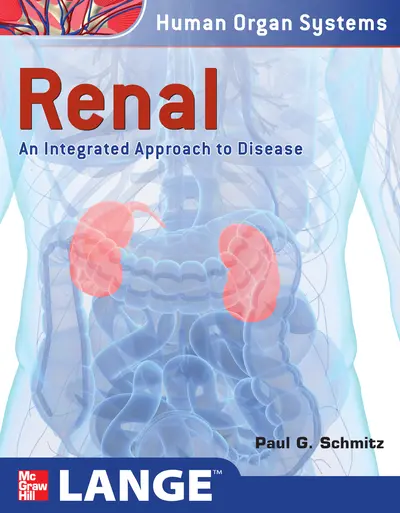My Account Details

ISBN10: 0071621555 | ISBN13: 9780071621557

Step 1 . Download Adobe Digital Editions to your PC or Mac desktop/laptop.
Step 2. Register and authorize your Adobe ID (optional). To access your eBook on multiple devices, first create an Adobe ID at account.adobe.com. Then, open Adobe Digital Editions, go to the Help menu, and select "Authorize Computer" to link your Adobe ID.
Step 3. Open Your eBook. Use Adobe Digital Editions to open the file. If the eBook doesn’t open, contact customer service for assistance.
Publisher's Note: Products purchased from Third Party sellers are not guaranteed by the publisher for quality, authenticity, or access to any online entitlements included with the product. An innovative, organ-specific text that blends basic science with the fundamentals of clinical medicine Part of the Human Organ Systems series, Renal: An Integrated Approach to Disease skillfully bridges the gap between the science and practice of medicine. This beautifully illustrated book seamlessly integrates the core elements of cell biology, anatomy, physiology, pharmacology, and pathology, with clinical medicine. It is the perfect companion for medical students transitioning to their clinical years, as well as practicing physicians who need a user-friendly update on the basic science underlying the practice of clinical medicine. Features and highlights include: Detailed learning objectives clearly state learning goals Core content emphasizes concepts and incorporates the latest developments in the field Beautifully illustrated with detailed legends to clarify important or difficult concepts Abundant clinical example boxes highlight the clinical implications of basic science Each chapter is accompanied by an annotated bibliography to provide an overview of the critical literature in the field A bulleted summary at the end of each chapter highlights the “big picture” and facilitates preparation for standardized exams End-of-chapter case-based questions with detailed explanations reinforce important concepts and assess mastery of the material Medical students and residents will find Renal: An Integrated Approach to Disease an invaluable study guide for an organ-system based curriculum. The book also serves as an excellent primer for postgraduate residents entering a nephrology fellowship program.
Foreword
Preface
Acknowledgments
Abbreviations
Section I: Renal Anatomy
1. Normal Development and Congenital Anomalies, Paul G. Schmitz
2. Gross and Microscopic Anatomy with Functional Correlations, Paul G. Schmitz and Bahar Bastani
Section II: Renal Physiology
3. Body Fluid Composition and Fluid Administration, Paul G. Schmitz
4. Glomerular Hemodynamics, Paul G. Schmitz
5. Principles of Renal Clearance, Paul G. Schmitz
6. Transport of Electrolytes and Water in the Proximal Tubule, Paul G. Schmitz
7. Transport of Electrolytes and Water in the Loop of Henle, Paul G. Schmitz
8. Transport of Electrolytes and Water in the Distal Tubule, Paul G. Schmitz
9. Renal Endocrinology, Paul G. Schmitz and Kevin J. Martin
Section III: Electrolyte Disorders
10. Water Disorders, Paul G. Schmitz
11. Potassium Disorders, Paul G. Schmitz
12. Edema and Diuretic Use, Paul G. Schmitz
Section IV: Acid-Base
13. Acid-Base Physiology, Paul G. Schmitz and Bahar Bastani
14. Acid-Base Disorders, Paul G. Schmitz and Bahar Bastani
Section V: Kidney Disease
15. Approach to the Patient with Kidney and Urinary Tract Disease, Paul G. Schmitz
16. Glomerular Disease, Paul G. Schmitz
17. Tubulointerstitial Disease, Paul G. Schmitz
Section VI: Renal Failure
18. Acute Kidney Injury, Paul G. Schmitz
19. Chronic Kidney Disease, Paul G. Schmitz, Kevin J. Martin, and Bahar Bastani
Section VII: Miscellaneous Disorders
20. Hypertension, Paul G. Schmitz
21. Urologic Disorders, Paul G. Schmitz
Answers to Questions
Index
Need support? We're here to help - Get real-world support and resources every step of the way.